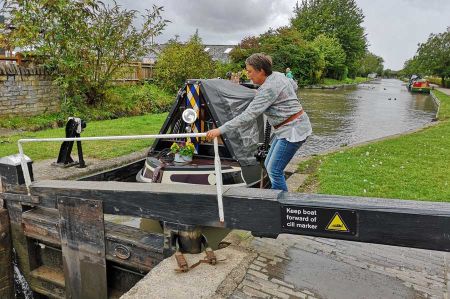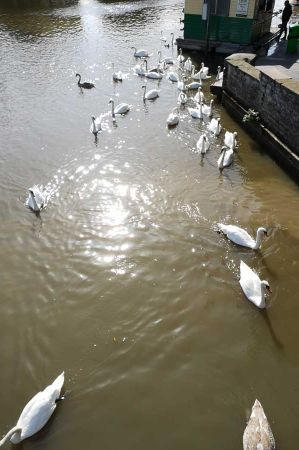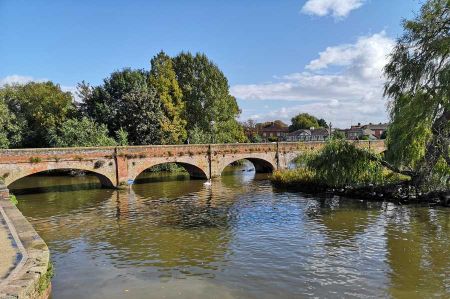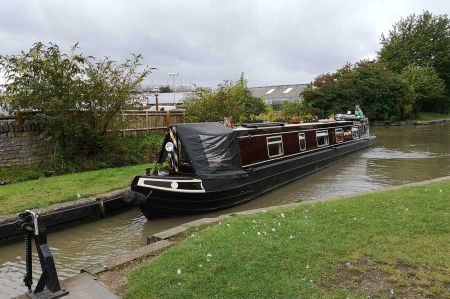Stratford-upon-Avon - Narrow-boats and Living on the water
- Written by Portal Editor
Stratford-upon-Avon - Once upon a time - this is how the story could begin - actually, many years ago we were on the English canals with one of the so-called Narrowboats for 10 days.
Together with a lovely family, we had rented a narrowboat at that time, traveling from London to Bath and Bristol. Had enjoyed the narrow canals with the even more narrow locks for recreational use and learned to appreciate the numerous pubs on the banks. It's been a long time ago, but unforgettable. So, watching the navigation of a narrowboat to pass through a lock in Stratford-upon-Avon, we had stopped enthusiastically on the shore, had had a short conversation with the boatmen and were deeply remembered.
Stratford-upon-Avon - The locks limit the boat size
 To enter one of the really narrow locks, a narrowboat must be less than 2,13 m wide. Most boats are just 2.08 m wide. This leaves both sides 2.5 cm space while passing the locks. We lived on the boat with 8 people, which is hard to believe, once you see the boats. Already at that time, we appreciated the canal and lock construction from the early days of industrialization and admired the steering ability of the narrowboats. The maximum length of a narrow boat is 21.95 m. Anything wider or longer cannot use most of the UK lock network. Some locks are even shorter than 21.9m (72ft), so the maximum length for accessing the entire lock system is 17.37m (57ft).
To enter one of the really narrow locks, a narrowboat must be less than 2,13 m wide. Most boats are just 2.08 m wide. This leaves both sides 2.5 cm space while passing the locks. We lived on the boat with 8 people, which is hard to believe, once you see the boats. Already at that time, we appreciated the canal and lock construction from the early days of industrialization and admired the steering ability of the narrowboats. The maximum length of a narrow boat is 21.95 m. Anything wider or longer cannot use most of the UK lock network. Some locks are even shorter than 21.9m (72ft), so the maximum length for accessing the entire lock system is 17.37m (57ft).
A narrowboat is a boat or originally a barge with a specific design, made for the narrow canal locks of the United Kingdom like you find them in Stratford-upon-Avon as well. The English canal system was once comparable to today's German Autobahn (which are stuffed with trucks, serving as a warehouse for German industry), when it has been the British "highway" at the time of the Industrial Revolution. With the advent of railways, commercial channel traffic gradually decreased and the last regular long-distance service disappeared in 1970. However, some commercial traffic lasted until the 1980s and beyond.
Narrowboat - vacation and permanent residences on the water
 Today's Narrowboats, like in Stratford-upon-Avon, are used for vacations, weekend trips, tours or as permanent or part-time residences, just as we had used the boat. The number of boats has increased significantly in recent years, also for tourist reasons, with the number of licensed boats on canals and rivers managed by the Canal & River Trust (CRT) estimated at around 27,000 in 2006 and over 30,000 in 2014 , For most of the narrowboats steering takes place via a tiller at the stern, we had used the navigation with a rudder.
Today's Narrowboats, like in Stratford-upon-Avon, are used for vacations, weekend trips, tours or as permanent or part-time residences, just as we had used the boat. The number of boats has increased significantly in recent years, also for tourist reasons, with the number of licensed boats on canals and rivers managed by the Canal & River Trust (CRT) estimated at around 27,000 in 2006 and over 30,000 in 2014 , For most of the narrowboats steering takes place via a tiller at the stern, we had used the navigation with a rudder.
To date, the use of Narrowboats is possible without a license, now you may think due to its maximum possible speed, easy to handle. Basically right. However, one should not underestimate the handling in the locks, even if it all seems very simple. However, a huge fun factor is always with you when the walker on the bank begins to overtake.
Back then we were witnesses to a lock accident in which a long narrowboat in a lock had initially reached its proper length, but then, with the drainage of the water, remained stuck on the concrete base of the lock gate and due to the difference in height in the lock the narrow boat was flooded from the bow. It took a day until the lock was usable again, because a crane had to lift the boat, so that the lock could be flooded again.
Where do narrowboats - cargo ships come from?
 The first narrow boats were coming into practise in the economic changes of the British Industrial Revolution. Initially, these were wooden boats pulled by a horse on the canal bank, which ran under the direction of a crew member on the towpath of the canal. A method also common in Northern Germany, in order to get peat from the bog areas. The horses were then gradually replaced by steam and diesel engines. By the end of the 19th century, it was common, almost a tradition, to decorate narrowboats with painted roses and castles. This tradition has been preserved to this day, especially for privately used boats that also serve as living quarters like we have seen in Stratford-upon-Avon.
The first narrow boats were coming into practise in the economic changes of the British Industrial Revolution. Initially, these were wooden boats pulled by a horse on the canal bank, which ran under the direction of a crew member on the towpath of the canal. A method also common in Northern Germany, in order to get peat from the bog areas. The horses were then gradually replaced by steam and diesel engines. By the end of the 19th century, it was common, almost a tradition, to decorate narrowboats with painted roses and castles. This tradition has been preserved to this day, especially for privately used boats that also serve as living quarters like we have seen in Stratford-upon-Avon.
Please read as well:
Longdendale Trail - hike up to the moor heights
Biking and Hiking Longdendale Trail to Woodhead Tunnel
-
 Narrowboat on the canals in Stratford upon Avon
Narrowboat on the canals in Stratford upon Avon
Narrowboat on the canals in Stratford upon Avon
Narrowboat on the canals in Stratford upon Avon
-
 Narrowboat on the canals in Stratford upon Avon
Narrowboat on the canals in Stratford upon Avon
Narrowboat on the canals in Stratford upon Avon
Narrowboat on the canals in Stratford upon Avon
-
 Narrowboat on the canals in Stratford upon Avon
Narrowboat on the canals in Stratford upon Avon
Narrowboat on the canals in Stratford upon Avon
Narrowboat on the canals in Stratford upon Avon
-
 Narrowboat on the canals in Stratford upon Avon
Narrowboat on the canals in Stratford upon Avon
Narrowboat on the canals in Stratford upon Avon
Narrowboat on the canals in Stratford upon Avon
-
 Narrowboat on the canals in Stratford upon Avon
Narrowboat on the canals in Stratford upon Avon
Narrowboat on the canals in Stratford upon Avon
Narrowboat on the canals in Stratford upon Avon
-
 Narrowboat on the canals in Stratford upon Avon
Narrowboat on the canals in Stratford upon Avon
Narrowboat on the canals in Stratford upon Avon
Narrowboat on the canals in Stratford upon Avon
https://www.alaturka.info/en/great-britain/warwickshire/4932-narrowboat-in-stratford-upon-avon-living-on-the-water#sigProIdc27488c28c

